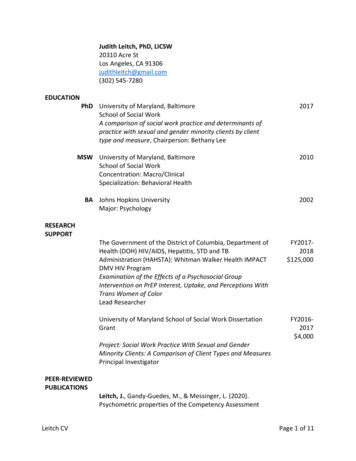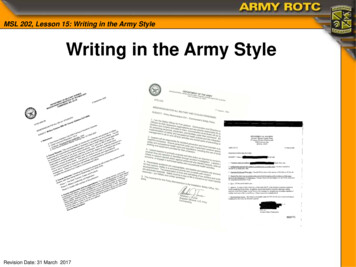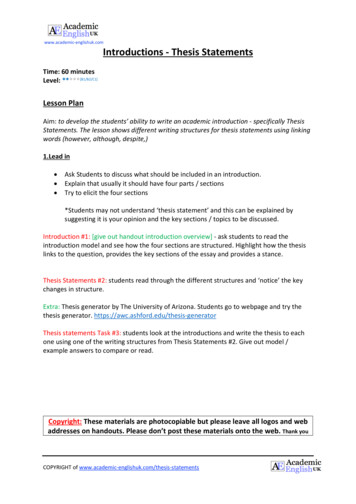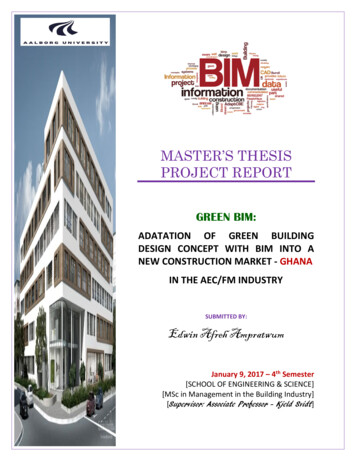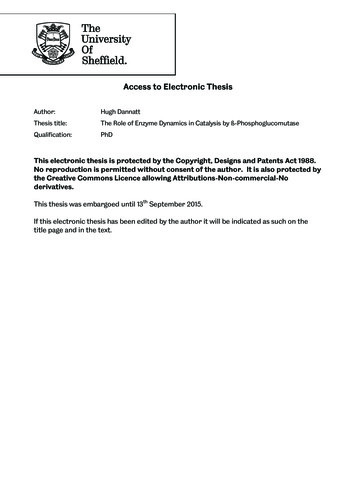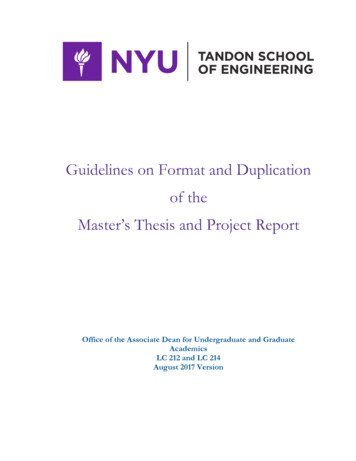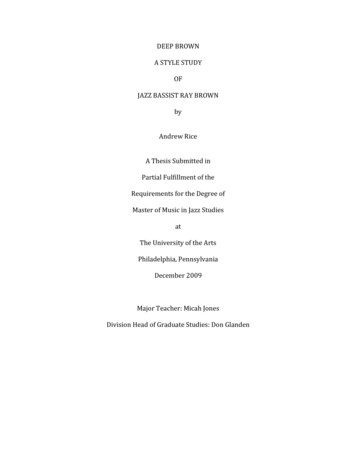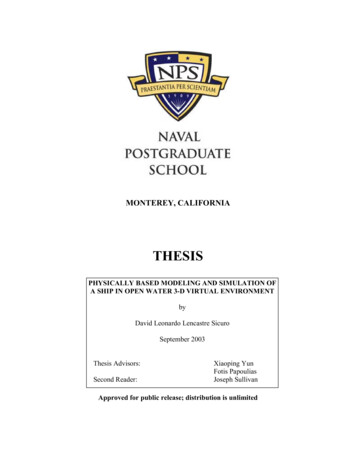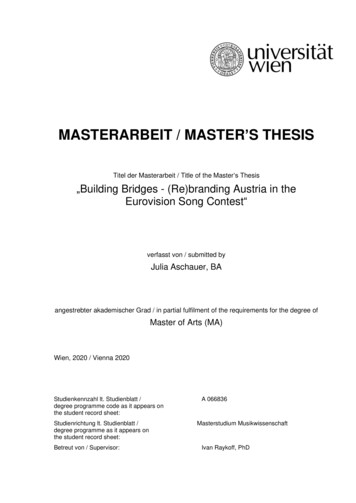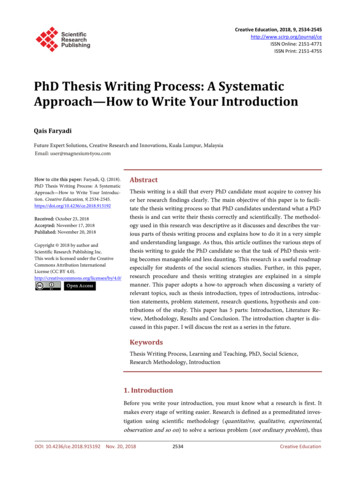
Transcription
Creative Education, 2018, 9, 2534-2545http://www.scirp.org/journal/ceISSN Online: 2151-4771ISSN Print: 2151-4755PhD Thesis Writing Process: A SystematicApproach—How to Write Your IntroductionQais FaryadiFuture Expert Solutions, Creative Research and Innovations, Kuala Lumpur, MalaysiaHow to cite this paper: Faryadi, Q. (2018).PhD Thesis Writing Process: A SystematicApproach—How to Write Your Introduction. Creative Education, 9, ceived: October 23, 2018Accepted: November 17, 2018Published: November 20, 2018Copyright 2018 by author andScientific Research Publishing Inc.This work is licensed under the CreativeCommons Attribution InternationalLicense (CC BY en AccessAbstractThesis writing is a skill that every PhD candidate must acquire to convey hisor her research findings clearly. The main objective of this paper is to facilitate the thesis writing process so that PhD candidates understand what a PhDthesis is and can write their thesis correctly and scientifically. The methodology used in this research was descriptive as it discusses and describes the various parts of thesis writing process and explains how to do it in a very simpleand understanding language. As thus, this article outlines the various steps ofthesis writing to guide the PhD candidate so that the task of PhD thesis writing becomes manageable and less daunting. This research is a useful roadmapespecially for students of the social sciences studies. Further, in this paper,research procedure and thesis writing strategies are explained in a simplemanner. This paper adopts a how-to approach when discussing a variety ofrelevant topics, such as thesis introduction, types of introductions, introduction statements, problem statement, research questions, hypothesis and contributions of the study. This paper has 5 parts: Introduction, Literature Review, Methodology, Results and Conclusion. The introduction chapter is discussed in this paper. I will discuss the rest as a series in the future.KeywordsThesis Writing Process, Learning and Teaching, PhD, Social Science,Research Methodology, Introduction1. IntroductionBefore you write your introduction, you must know what a research is first. Itmakes every stage of writing easier. Research is defined as a premeditated investigation using scientific methodology (quantitative, qualitative, experimental,observation and so on) to solve a serious problem (not ordinary problem), thusDOI: 10.4236/ce.2018.915192 Nov. 20, 20182534Creative Education
Q. Faryadicreating additional (new) knowledge. Research is also regarded as an inquiry ofreality about something by testing a hypothesis, answering questions, generatingnew queries, finding solutions, and creating new knowledge. The new knowledgemust be applicable/defensible and challengeable by other researchers, besideslending itself to generalization. For a piece of exploration to qualify as a research, it must pass through a set of rigorous examinations, such as validity(logical procedure to answer a question), reliability (quality of measurement),and unbiased conclusion (adequate measures are taken to make sure that it isfree from individual interest). As such, a PhD thesis must meet the above conditions of a scientific research procedure (Mincu, 2015).2. Problem StatementThesis writing is a skill that every PhD candidate must acquire to convey his orher research findings clearly. Unfortunately majority of PhD candidates find itdifficult to finish their thesis on time because of confusion and lake of expertise.Most of them in deed do not know how to write the PhD thesis correctly andscientifically.3. Objectives1) To help PhD candidates in writing scientifically correct PhD thesis.2) To describe PhD thesis writing process.3) To assist PhD candidates to understand what PhD means.4. MethodologyThe methodology applied in this research was descriptive as it discusses and describes the various parts of PhD thesis and explains the how to do of them in avery simple and understanding language. Descriptive analysis is applied to explain the basic features of thesis writing process (García & Fombona, 2015). Descriptive method is very useful in providing basic summaries of the chapters(Al-Raqqad et al., 2017). The following are the process of PhD thesis writingprocess.4.1. Introduction Writing ProcessAn introduction is the most difficult parts of a PhD thesis. The introductionopens a dialogue with your examiner or reader. As such, a good introduction iscritical to capturing the attention of your readers and engaging their interest inyour research. Your introduction must convince your reader that you are theright person among thousands of researchers. You must also show your readerhow you going to fulfil their needs and what exceptional benefits they can getfrom you as a researcher. You should convince your readers that you are an authority on the subject of investigation (Faryadi, 2017). Consult your supervisorsor your department about the format of your thesis before starting to write. Institutions may vary in their requirements with regard to thesis-writing. NeverDOI: 10.4236/ce.2018.9151922535Creative Education
Q. Faryaditheless, the following checklist provides some general guidelines:1) Consult your supervisors.2) Familiarize yourself with the style or format of thesis writing.3) Decide on the word length. How many words your thesis should be.4) Learn more about referencing styles.5) Make sure you have all the necessary information for the reference section.6) Learn about indexing of your thesis.4.2. Tips for Writing the Introduction1) State the problem or phenomenon to be investigated.2) Identify the party affected by the problem.3) Explain how you plan to solve the problem.4) Convince the reader that you are qualified and equipped with the right methods of solving that problem.5) Highlight the benefits of solving the problem.6) Tell the reader what results you anticipate.a) As evident from the above, in your introduction, you should communicatethe rationale of your research. Explain the importance of your research. Eventhough your research introduction chapter has no word limit, being concisehelps your readers to comprehend quickly the major issues in your research.When you eventually start writing the introduction, start with some relevantgeneral statements before gradually narrowing it down to focus on the crucialissues such as your research problem, questions, objectives and hypothesis.Here, you explain briefly your research problem and how you plan to solve it.Your introduction must be motivating and captivating enough so that thereader will want to read on to find out more.b) It is assumed that your introduction is prepared for readers who have adequate knowledge of your discipline. Your introduction includes many crucialaspects of your thesis. Readers may want to know whether it is your owndiscovery, or you are continuing a previous study. If it is your own scientificdiscovery, then you must make it clear how the findings will add to the existing knowledge (Kafes, 2018). Your reader would also want to know moreabout the concepts used in your research, the objectives of the research, andthe methodology employed. You could also discuss the obstacles encountered, if any, and the limitation of your research.4.3. Roadmap for Developing Your Introduction1) Write clearly.2) Be precise and concise in your introduction.3) State your problem statement clearly and explain why the problem is worthyof investigation.4) State your objectives clearly.5) State your hypothesis and explain briefly how you would test it.DOI: 10.4236/ce.2018.9151922536Creative Education
Q. Faryadi6) Keep the best for the last. Your introduction is one of the best parts of yourthesis. If it is possible, write it once everything is finished. In this manner,you will not miss anything important and significant.As you can see from the above guidelines, the introduction is crucial in conveying your ideas, thoughts and your message to the world. A good introductionpaves the way to showcasing your thesis. As such, while it is important to conveyyour message loud and clear, your introduction must be well-organized, convincing, and be engaging. Prepare your introduction as a preview to your readersso that they can judge the rest of your work and its significance at a glance(BCCC Tutoring Centre).4.4. Type of Introductions1) Illusion Introduction: Start your introduction with an illusion style statement so that your reader cannot resist reading on.2) Analogue Introduction: Start your introduction with a comparison so thatyour reader is eager to know the differences.3) Narrative Introduction: Start your introduction with an eye-catching storyto capture your reader’s attention.4) Descriptive introduction: Start your introduction with a descriptive statement about your title. Once you start describing something, readers becomeeager to continue reading.5) Definition Introduction: You may begin your introduction by defining apart of your topic, thus creating a knowledge transferring environment foryour reader.6) Example Introduction: Begin your introduction with an interesting exampleso that your reader takes it as personal motivation for writing his/her ownthesis introduction.7) Question Introduction: Start your introduction by posing a question; it willkeep your reader thinking and yearning to know the answer.8) Statistic Introduction: You can start your introduction with statistics concerning the parties affected by the problem that you will investigate.9) Quotation Introduction: Start your introduction with a quotation that is relevant to PhD thesis writing so that your reader takes it as a personal motivation.4.5. What Is an Introduction Statement?Your thesis statement is a declaration of your topic and a claim of how you aregoing to prove or disprove your problem. It is found in the first paragraph of theintroduction where you declare that you have an important subject to present.Your argument should be persuasive or informative. In any of these two methods of presentation, you show your assertion and view point about your entirethesis to your readers (Koçyigit & Erdem, 2018). Here is how you write a goodthesis statement:DOI: 10.4236/ce.2018.9151922537Creative Education
Q. Faryadi1) Make an assertion about your style of interpretation.2) Capture the attention of your reader.3) Know what your readers anticipate and provide them with answers.4) Challenge your peers about the severity of the research problem and put forward your proposal for a solution.5) Finally, organize existing evidence relevant to the problem and interpret itclearly and logically.As apparent from the above roadmap, develop your thesis statement (introduction) starting from a general argument and narrowing it to focus your rationale on how the research should proceed. The rest of your paragraphs in yourintroduction should support your claims. Don’t argue on facts, but use them toprove or disprove your claims. Always give evidence from scholarly documents.In short, your statement is a fundamental part of your introduction. So, writeyour statement carefully and thoughtfully. After all, the main purpose of yourintroduction is to introduce your topic to the readers (Banus & Dauda, 2015).Take note that readers may not read your introduction until the end if you fail tocapture their attention and interest. Your introduction can only stand out if yourelate it to everyday life and convince readers of its practical importance. Hence,your introduction must be motivating, current, and be based on a strong methodological and theoretical certainty.4.6. How to Write Your Problem StatementThe problem statement states a specific condition (issue) that needs urgent attention and a possible solution. As a researcher, show your readers how yourinvestigation will fill or narrow the gap in existing literature. An excellent problem statement is just a line or two. The rest of the paragraph(s) is its elaboration,discussing a possible solution and most importantly, why it is a problem thatneeds urgent attention (cite scholarly references). The problem must generatequestions for the researcher to answer (Faryadi, 2012).A PhD thesis problem statement must seek to answer the following questions:1) What is the problem?2) Where is the problem?3) How can the problem be solved?4) Why do you want to solve the problem?5) Is the problem a current issue?6) Will the problem persist if it is not solved?7) Who are affected adversely by the problem?8) Will this problem prove or disprove existing knowledge?In short, the problem statement describes an existing issue which is so gravethat it must be addressed. Generate questions about your problem statement andtry to answer those questions to prove or disprove your research problem.Hence, the research problem is the main part of any scientific enquiry (Jacobs,2013).DOI: 10.4236/ce.2018.9151922538Creative Education
Q. Faryadi4.7. Importance of the Problem Statement1) It highlights the importance of your thesis topic.2) It creates interest among researchers.3) It adds new knowledge.4) It identifies a gap in the literature.5) It indicates a need for future research.6) It stimulates thinking about what else is required to solve future relatedproblems.4.8. Some Don’ts When Writing a Problem Statement1) Is it researchable? If your problem is so difficult or complex that it is beyondthe ability of the researcher, then it will lead to a wastage of time and resources.2) Do you have relevant scholarly documents? If nothing has been written aboutyour research problem, perhaps the problem is not worthy of investigation.3) Are you a suitable person to do this research? Are you qualified? Do you havethe necessary skills to carry out this study? If your answer is no, then timeand resources will go to waste if you proceed.4) Will solving the problem bring practical benefits? Do you think this researchcontributes to society? Will it bridge the knowledge gap? Is your researchchallengeable? Which category of society will benefit from this research?4.9. Selection of a Research Problem1) Interest: Pose a problem that you find it fascinating so that you will be motivated to investigate it further.2) Knowledge: Do a background study of your research problem so that youcan discuss it with conviction and authority.3) Conceptual frame work: Your research problem must be theoretically andconceptually sound.4) Data availability: Investigate a problem that you can find materials andsources to support your investigation.5. How to Write Your Research QuestionsThe research question is one of the essential parts of a thesis. It focuses on thestudy, regulates the methodology, and guides all the stages of investigation,analysis, and finally answers the problem statement. There is a difference between your topic and your research question. The topic is meaningless without agood research question. Your research question should reflect and elaborate adeeper understanding of your topic (Demir Kaçan, 2015). Your research question should also seek to erase all ambiguity about your research problem.It may even guide you in the type of investigation you should conduct, identify the type of data you should collect, and lead you to a proper analytical approach of your data. In short, a good research question helps you to focus on fiDOI: 10.4236/ce.2018.9151922539Creative Education
Q. Faryadinishing your investigation without wasting much time and resources. Moreover,good research questions create a corridor to your research. They act even like thespine of your proposal and later, your thesis. Good questions are the ones thatcan be answered by researchers as they are supported by evidence. In short, goodresearch questions that lead to investigations help eliminate serious problemsfrom our society (Tenenberg, 2014).5.1. Writing Research Questions1) Choose a topic that interests you and your readers. It must bethought-provoking. Make an investigation of your topic by going throughscholarly journals to see what questions are raised by your peers. Take noteof what questions are not raised so that you can add them to your list. Yourresearch question should not be answered just by simple facts; it should require critical analysis and field-tested research. Your research questionshould not cover an area that is too broad or too narrow. If it is too narrow,you will have difficulty finding relevant information.2) Do not forget to show your research questions to your supervisor beforegoing into details.When formulating research questions, we ask how the research problem originated and subsequently progressed to a serious state. Researchers ask questions and put their hypotheses in context. The hypothesis indicates the researcher’s line of thinking as he/she predicts specific relationships or situations. It mayturn out to be true or false. As such, in order to hypothesize or make predictions,researchers need relevant knowledge and skills. To prove or disprove a hypothesis, researchers are compelled to ask questions about the problem to be studied.They test the questions in the field by gathering relevant information and datato test their hypotheses, and by conceptual knowledge and thorough analyticalinvestigation. When researchers carry out an investigation about a specificproblem, they ask questions that require either a description or explanation. E.g.Does a skillful and knowledgeable person perform well in the field? Questionsmay also indicate what, where, and when a problem occurs. With explanatoryquestions, researchers always start with why. For instance: Why did the wall ofthat building collapse? What was the cause of it? Research questions can also indicate future events. What will be the final grade of your students once they usethe new information system in their classroom? This type of question is a hypothetical or predicted question. It is all about state of the mind and understandingof the researcher. Prediction is not real knowledge. It becomes knowledge once itis investigated and proven. Beside descriptive or explanatory questions, researchers may also ask open-ended and closed-ended questions to solve researchproblems. A closed-ended question is just the opposite of an open-ended question.A closed-ended question requires an answer that is either Yes or No. Did youattend your History class this evening? Answer: Yes/No. For an open-endedDOI: 10.4236/ce.2018.9151922540Creative Education
Q. Faryadiquestion, there is no specific response. It is open to discussion. For example:What do you think about my class performance this morning? You can see thatthe answer is not Yes or No, but it requires an opinion. Hence, as a researcher,you are required to ask various types of questions in order to obtain the necessary information for your study.5.2. Why Do Researchers Ask Question?1) Questions guide the researcher to find suitable answers to solve the researchproblem.2) Asking questions helps the researcher focus on the topic under investigation.3) It helps the researcher focus on the important issues in his/her thesis.4) It helps the researcher find answers for his/her research hypotheses.6. What Is a Hypothesis?A hypothesis is an unproven reasoning. It enables an educated guess or a prediction of a result or relationship under specific conditions. It requires rigoroustesting to determine its validity and reliability. Once it is proven after serioustesting, it becomes a scientific theory. “A hypothesis is an idea or explanation forsomething that is based on known facts but has not yet been proved.” “A hypothesis (plural hypotheses) is a proposed explanation for a phenomenon.” “Hypothesis is an assumption or concession made for the sake of argument , an interpretation of a practical situation or condition taken as the ground for action, atentative assumption made i
As apparent from the above roadmap, develop your thesis statement (intro-duction) starting from a general argument and narrowing it to focus your ratio-nale on how the research should proceed. The rest of your paragraphs in your introduction should support your claims. Don’t argue
